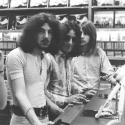Leonard Bernstein talked about “the infinite variety of music” and the late maestro would have been thrilled by the variety on display at the Royal Festival Hall where Rhiannon Giddens and Francesco Turrisi were as exciting and exhilarating as anything I’ve heard.
Their performance, part of the EFG London Jazz Festival, lasted two hours but could have gone on for 22, a display of brilliant musicianship and total engagement that was breathtaking, two classically trained performers absolutely in command of their material and sharing their love and knowledge of it. The prior evening Giddens and Turrisi had opened their UK and European tour in the Chapel at HM Prison Wormwood Scrubs and one can only imagine the redemptive power of such a performance in those circumstances.
Working with the piquantly named Jason Sypher on string bass and Alphonso Horne on trumpet, Giddens and Turrisi drew heavily on their recent album there is no Other, recorded over five days in Dublin and produced by Joe Henry. The concert, like the album, explored the universality of music and the connectedness of our shared musical experience, wherever we may be. In short, our common humanity.
Since abandoning opera, Giddens has dedicated herself to exploring the music of the African-American diaspora. Turrisi, a Sicilian who majored in jazz and early music, is her European equivalent, exploring the ways in which western, North African and Arabic musical traditions have mingled and melded. Between them they cover the waterfront, musicians without borders whose collaboration is itself a stand against otherness. The array of instruments played by Turrisi tells its own story: frame drums from Iran and North Africa (the bodhrán is the Irish equivalent), the calascione, and the tamburello, the latter very different from “the Jesus tambourine” that Giddens briefly flourished in the Sister Rosetta Tharpe finale, from which Turrisi coaxed a mind-blowing range of sounds. (The amplification of such instruments is surely an art in itself.)
The music of black minstrelsy – all fiddle, bones and banjo, an instrument which originated in Africa – was given a taboo-busting celebration, Giddens pointing out its importance in the musical continuum, even the “coon songs”. She sang “Underneath the Harlem Moon”, the Ethel Waters version, which deals head-on with the song’s racism. The musical tour d’horizon embraced a slave song from Cuba, another from the trans-Siberian railway and “Brown Baby”, here given an Arabic accent, as well as instrumentals such as “Following the North Star”, played on Giddens’ fretless and mellow-sounding wooden banjo.
Turrisi, with engaging enthusiasm, explained the origin of the tamburello and the tarantella it accompanied, a trance-dance which in the Puglia region is named the pizzica. Singing in local dialect to the accompaniment of tamburello and bass, Giddens gave a bravura performance of “Pizzica di San Vito” which had much in common rhythmically with “Molly Brannigan”, sung in honour of Giddens’ and Turrisi’s adopted homeland. “Wayfaring Stranger”, among the best known of the Roud collection of folk and gospel songs, was exquisitely plaintive.
There were virtuoso performances all round, Giddens' carefully calibrated vocals negotiating some tricky intervals and microtones, not least on “Black Swan” from Menotti’s two-act opera The Medium. She’s not too shabby on fiddle and banjo, either. Turrisi was charming, wittily erudite, his enthusiasm infectious. In addition to so much exotic percussion, he also played piano accordion and, in the Menotti, reached inside the Steinway to pluck and strum its strings. Sypher’s bass contributions, sometimes bowed and sometimes plucked, featured perpetuum mobile-type figures and drones.
It’s not quite 15 years since Giddens graduated from Oberlin Conservatory and began exploring the music of what Greil Marcus has referred to as “the old weird America”, its roots in the history and blood-stained soil of the south. She’d been singing Italian arias while waitressing in a pasta joint and had saved enough greenbacks to buy a banjo and a fiddle, learning at the feet of old Joe Thompson, a descendent of Frank Johnson, born on a 19th century plantation and an itinerant fiddler who was a key figure African-American music. Giddens met Joe in 2005 at Black Banjo Then & Now, a festival at Appalachian State University, and the Carolina Chocolate Drops were born. The band went through several iterations during its award-winning career while Giddens got her big break in 2013, performing at New York Town Hall in Another Day, Another Time, a starry folk concert marking the release of the Coen Bros movie Inside Llewyn Davis, based on the memoirs of musician Dave van Ronk. Her star rose rapidly, and she has moved effortlessly back and forth across musical boundaries, performing at both the Newport Folk and Jazz Festivals among many others, writing music for a ballet, podcasting for the Met, and even acting in a TV series.
She’s already created a body of remarkable work which Turrisi recognised was the missing link in his jazz research. Their collaboration is as exciting as it is important.















Add comment